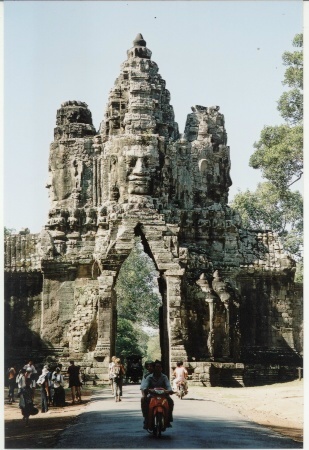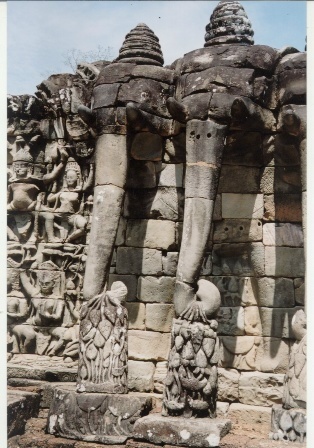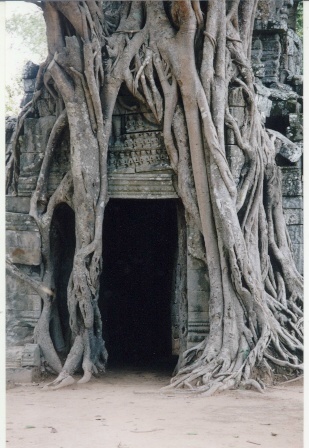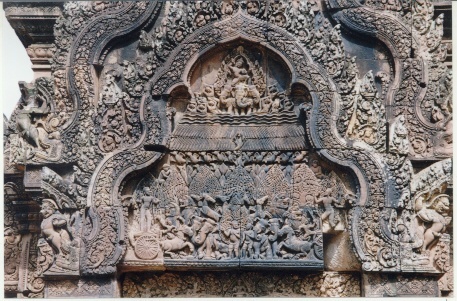19 May 2003: Siem Reap, Cambodia
Well after an all-day bus journey from Bangkok I eventually got
here to Siem Reap, tourist capital of Cambodia. It's not a country I
ever imagined that I'd visit but I'm very glad that I came here. Just
up the road are the famous temples of Angkor, but first...
Happy Birthday to Me!
My birthday was on the 17th and I had a
great time, thanks to Siem Reap's Norwegians! I share my birthday
with Norway - it is their national day. So Meg and Aina, the two
girls I've been travelling with since Bangkok, met up with half
a dozen of their compatriots for a night at the "Angkor What?" bar.
Here are the last five of us left in the bar at the end of the
evening:
The Temples of Angkor
Back in about 800AD the Khmer nation came into existence and
they started building things. For five hundred years or so practically
every king built some sort of temple. Then the capital moved from
here down to Phnom Penh and the jungle started to take over.
The French did a good job of exploring, recording and conserving the
ruins until 1972 and the start of Cambodia's long series of civil
wars (an appauling story, not least because when the Cambodians were
liberated from Pol Pot they made the mistake of being liberated by
the communist Vietnamese; they were so hated by the Americans that
the Khmer Rouge kept the Cambodian United Nations seat for another
decade and no international aid got into the country). In the last
few years things have got a lot better here and I don't hestitate to
recommend it as a place to visit (as long as you can cope with the
heat). It is certainly going to need a lot of visitors to fill
even half of the rooms in the huge luxury hotels that are now being
built.
We spent three days looking around the temples. On the first day
we spent the morning at the city of Angkor Thom, which is enclosed by a
moat and wall and had an estimated population of a million people!
Here is the south gateway:
Inside there are several temples, the largest of which is the Bayon.
Like most of them it is a tiered structure ("pyramid" - obviously inspired
by aliens :-) ) with concentric
walls. There is lots of nice carving, including many images of the king's
face on the towers representing his omnipotence. Here is a detail from
a column showing a couple of Apsara dancing figures:
There is also a
three hundred metre long terrace wall with life size elephants carved
into it. Here are two heads of a three-headed elephant plucking lotus
flowers with their trunks:
In the afternoon we went to Angkor Wat itself,
a spectacular temple built
on three levels with a moat around it that apears on the Cambodian flag.
It features
some excellent bas-relief wall carvings depicting military parades,
religious scenes (Hindu and Buddist - they were influenced by indians
because of the sea trade routes between India and China), and a few
bits of daily life which looks quite similar to life in the countryside
today.
Some structures are well
preserved and others have been well reconstructed, but on the second
day we saw some that are so
in the grip of the jungle that it would be impossible to remove the
trees - the strangler figs grip the stones in their roots, both
crushing and supporting them at the same time.
On the last day we went to Banteay Srei, a more remote temple that
is has been carefully conserved and has excellently preserved carvings,
partly because they used good quality sandstone. It's clear enough that
you can easily follow the Hindu epic stories being depicted. On this
pediment, Indra is casting down sacred rain (the diagonal lines half
way down):
So that's all from Siem Reap. Next stop Phnom Penh and then Vietnam.
27 May 2003: Hanoi, Vietnam
Phnom Penh
So after four days in Siem Reap mostly spent looking at temples we got
on another
bus for the ride to Phnom Penh. This road was supposed to be better than
the one from the Thai border to Siem Reap, but it was still a slow journey.
It was raining in the morning and the unsurfaced road was
getting muddy - it makes you try to imagine how much worse it gets when it
has been
raining for a few months. But soon it will be transformed as everywhere
there was construction work going on, mainly building new bridges. Because
of the wet/dry climate they can simply fill the river channel with earth
to make a temporary road during the dry season while they build a new
bridge alongside, and we saw them in every stage of construction (except
finished).
We were delivered to a pleasant, air-conditioned hotel with cable
TV (BBC!) ... on a muddy dirt road in what felt like one of Phnom Penh's
dodgier areas. (More about the way they "deliver" you to a hotel later.)
First impressions of Phnom Penh were not bad: there are shops selling all
of the essentials of daily life, plenty of places to eat and so on. It
is remarkable to think how different it must have been twenty years ago.
Our first outing was to the Royal Palace, a large compound with
various temples and other buildings in the Buddist style. The highlight
is the Silver Pagoda, a temple whose floor is made from solid silver
tiles weighing five tonnes. Frankly it's not very impressive as most of
the floor is covered with carpets so that you can walk on it, and the tiles
that are exposed could do with a polish. Even I could think of more
interesting things to do with that much precious metal! Inside there are
cabinets full of assorted silver and gold nic-naks,
all in need of a dust apart from
the huge 90kg gold buddah, bejeweled with diamonds of up to 24 carats.
Some readers would have been more interested in another part of the
complex where they had a traditional cambodian stilt house complete with
loom in the space underneath. There was a lady there weaving silk in
the technique where it seems that the fabric has been dyed with a pattern
and then un-woven and woven again. (Why do they do that?)
We also wandered down to the river. Phnom Penh is at the
confluence of the Mekong and the Tonle Sap rivers. During the wet
season the Mekong delta (southern Vietnam) can't take all the water
coming downstream and the flow in the Tonle Sap river reverses.
This fills the Tonle Sap lake and is the basis for Cambodia's
rice growing - they have a special variety that grows fast enough to
keep up with the rising water level - and fishing. It was possible to
see the far side of the Mekong river, but it was a long way away. Was
it the widest river I've ever seen? Probably, exluding estuaries.
For some recent history we went to the Choeng Ek genocide
memorial. If you've seen pictures of hundreds of skulls pilled up
on wooden trestles, this is the place (see, for example,
http://www.terragalleria.com/theravada/cambodia/phnom-phen/picture.camb2951.html)
- though five years ago they
built a buddist stupa (tower) to house them:
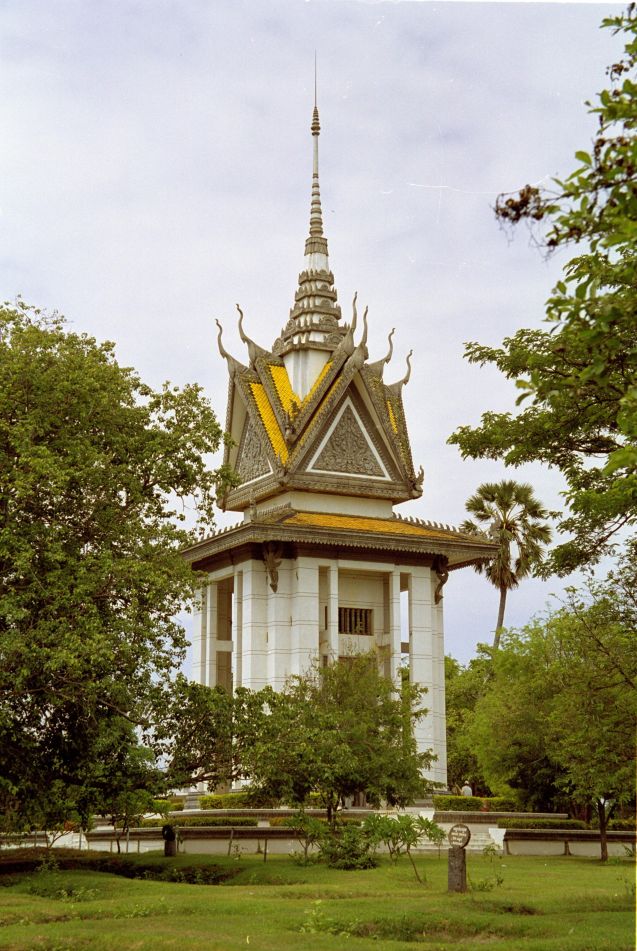
There are also the
remains of the mass graves that they excavated around which odd bits of cloth
and a few bits of bone are still sticking out of the ground.
Pol Pot's regime is
said to have been responsible for a million or more deaths, most of
them through starvation but a significant number in extermination camps
like this; there are eight thousand skulls at Choeng Ek.
Most of the victims were bludgeoned to death with things like
agricultural implements as bullets were considered too valuable to waste
on them. (Remember that in China the families of executed prisonners
are still often sent a bill for the bullet used.) Despite the significance
of the place I wasn't particularly moved by it - not sure why. Apparently
the former Tuol Sleng prison in Phnom Penh, where the victims were
interrogated before being sent to Choeng Ek, is a more moving experience,
but I didn't go. Only Meg went there while Aine and I went to the
National Museum to see some bits of carved stone that were considered
too portable to leave in situ at Angkor. It's not a bad museum - at
least they have labels on everything, even if they do often say
"unknown origin, unknown date".
So after all that Meg and Aina set off back to Norway via
Sihanoukville, Bangkok and London and I got on a plane to Hanoi, with
a half-hour stop at Vientiane in Loas to boost the country-count for
the trip so far to seventeen. More about Hanoi later.
How Tourism Works in Cambodia
As a tourist in Cambodia, things can be even cheaper than you
expect them to be. That's because prices are set very low to get
your interest, and then they try to sell you other things on which
they hope to make more profit. Here's what can happen:
You get a bus from Bangkok all the way to Siem Reap (all day)
for only 150 Baht (less than three pounds). They make a loss on this,
but the bus delivers you to their guesthouse in Siem Reap where they
hope to make enough profit to pay for the trip. But the guesthouse is
cheap too - only $3 per night for a good room - because they want
you to book your transport to the temples through them (and earn their
commission on the deal). Your driver will then drive you to the
temples, but what he really wants to do is to take you to his
favourite restraunts where he'll earn a percentage. At the restraunt
you want to eat, but the first few pages of the menu are advertising
bus trips....
It's all a bit bizzare and I'm not sure what I think of it.
I wonder if it indicates an underlying oversupply of services and
not enough tourists - no-one can make any money themselves so they
try to make something from someone else's business. But like a
pyramid scheme it's bound to fail, except perhaps for a few
central players. There was quite a scene when we got to Siem Reap
and announced that we were going to a different hotel - one with
a Norwegian manager and guaranteed party for the 17th May. I'd
rather pay for what I think I'm paying for and not be in debt to
someone who has given me something at below cost price. On the
other hand it does mean that you can travel very cheaply.

